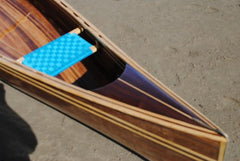To Build The "Waist Nought" Cedar-Strip Canoe by Bruce Kitchen, Lakefield, ON Canada
Posted on June 09 2014

In about 2004 I was puttering around in a bookstore at an outlet mall when I saw a copy of Canoecraft for $10.00. It seemed like it had been bumped around a bit and was on sale. After looking inside I realized the instructions were very detailed so I followed my whim and bought it. My other reasons included knowing I was about to retire, my dad used to build boats, and I had a yen to make something from wood. Canoes seemed so graceful and elegant and I had inherited a lonely pair of paddles.
In 2006 my daughter's wedding was approaching and about 2 weeks before the big day while we considered household details to be fixed up, it became evident that the 20 year-old cedar top of our deck was too eroded for a large post-wedding group to place narrow legged chairs on. "It has to be replaced," my wife said. We pulled off all the cedar and I noticed how solid and colourful many of the boards were inside so I resolved to save them for later use. For three years they lay under a blue tarp while major renovations including a new garage/shop were added to our house.
As with many retirees, I was asked by younger siblings and spouses what I would do after stopping work. Carelessly mentioning my pipedream of building a canoe or kayak to a sister-in-law was the eventual spur . The winter of 2007/08 went by and the next summer season she asks how I'm doing on that canoe. I sheepishly admitted that nothing had been done. It was embarrassing to think I had let myself down even while I had been assembling a modest shop. A little reading of Canoecraft showed I had sufficient capability now to make what Ted described. This forced me to plan some deeds to get the project underway. Even a few years earlier at a Peterborough showing of antique and wooden boats I had picked up a copy of the Bear Mountain catalogue. I found Joan and Ted's number and phoned about coming to their shop to look at plans etc. After a little chat I was able to decide that a "Ranger" would be the most appropriate design for me and I bought the plan.
As the winter of 2008/09 began I thought, maybe now I can get to that dream project. So finally in March of 2009 inside my new shop I began to follow Ted's instructions building a strong back bench to get started. There followed a lot of sawing of the often knot riddled cedar deck leftover planks to get 3/4"X1/4" strips. I was living by my maxim of "Waste not/want not" which later led to the (tongue-in-cheek) name in the title above. My wife helped run the strips through the router to put on bead and cove edges. With some more personal functional guidance from Ted and others I began installing and gluing together the strips using the no-staple technique and the hull began to take shape. The book seemed to have just the right amount of encouragement to keep a results-oriented guy like me going.
Taking up an offer from Denis Gagne I assembled a small crew, which Denis led, to do the fibreglass and epoxy "lay-up". The first real look at it when it was as wet and smooth as a lollipop certainly convinced me this was a very worthy project. Many compliments have come my way since.
It took some time and effort to build and install the gunwales, decks, seats, handles and portaging yoke, but a lot of satisfaction came my way too. I built it to a standard plan, but it ended up being unique, due to the varied character of the former "deck" cedar (some pinkish strips were from my dad's veranda sofa)as well as the style of scuppers cut, and the gunwales made of oak (from a family woodlot), decks of cherry, and seats of ash. The heirloom source pieces make the canoe a family treasure. Only the seats were purchased ready-made with cane seat pads. A friend later joked that I had built a "deckboat" shaped like a canoe.
The forgotten third or so of the work, sanding and varnishing did mercifully come to an end and we went to Warsaw, Ontario for her maiden voyage. That first casting-off from shore and gliding away so smoothly and serenely proved to me that the effort had already been worth it. She is light, strong, and carries a good sized load and has taken us very quietly to visit young osprey , loons, kingfishers, turtles, herons, etc. in the five years since. My grandchildren and their parents have enjoyed getting out on the local waters in it too. Even a trio of visiting brothers from southern France had an opportunity to try it as the quintessential Canadian part of their trip experience.
What now? Well, to will a hand-made vessel to each of my children requires that I build at least one more of these gorgeous craft, so I've started to build another Ranger this spring. There appears to be just enough "deck" cedar remaining to do the job!










